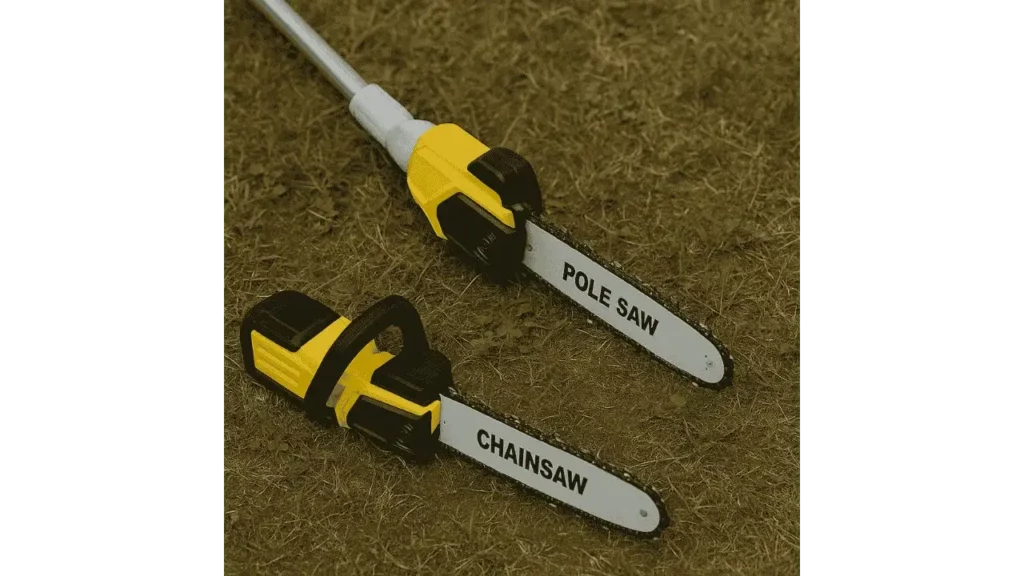Have you ever looked at a pole saw and wondered if it could double as a chainsaw for your ground-level cutting tasks? At first glance, it might seem like a reasonable idea; after all, both tools have chains and cut wood. But in reality, while pole saws and chainsaws share some similarities, they are built for very different purposes. Using a pole saw as a chainsaw may not only be inefficient but could also pose safety risks and lead to equipment damage.
“People often mistake pole saws for lightweight chainsaws, but they serve very different purposes,” explains Ethan Moore, certified arborist and tool expert at GardenEdge Tools.

Understanding the Differences
What Is a Pole Saw?
A pole saw is essentially a small chainsaw attached to the end of an extendable pole. It is specifically designed for overhead pruning and trimming tasks. These tools are most useful for reaching high branches without a ladder, making them ideal for tree maintenance around the home. The cutting bar is usually shorter, and the overall structure is built to be lightweight for extended vertical use.
What Is a Chainsaw?
Chainsaws are designed for cutting wood at ground level or waist height. They have larger, more powerful engines and longer guide bars, making them suitable for felling trees, bucking logs, and handling more demanding cutting jobs. Chainsaws require two-handed operation and are built for precision and balance during close-range cutting.
Read More: Proyama 68 CC Gas Chainsaw Review
Can You Use a Pole Saw Like a Chainsaw?
Situational Usage
Technically, yes, a pole saw can cut through wood just like a chainsaw. You could lower it and try to use it to cut logs or branches close to the ground. But just because you can doesn’t mean you should. Pole saws are designed for vertical movement, and using them horizontally often results in awkward handling and reduced efficiency.
Safety and Control Issues
Pole saws are top-heavy, and their long reach makes them difficult to maneuver for detailed ground work. Trying to use one like a chainsaw can lead to unstable footing, kickback, or loss of control.
“Attempting to use a pole saw for anything other than overhead pruning increases the risk of kickback and operator injury,” warns Linda Kay, safety instructor at TimberTech Academy. These tools lack the balanced design needed for safe, close-range work.
Design Limitations and Power Considerations
Bar Length and Power Output
Pole saws typically have shorter bars and smaller motors than chainsaws. They’re meant for smaller-diameter branches, not thick logs or hardwood stumps. Using a pole saw for these tasks could overwork the motor, dull the blade faster, and even cause mechanical failure over time.
Precision and Maneuverability
Chainsaws are designed with ergonomic grips and center-balanced weight for better control. This allows for cleaner cuts, less user fatigue, and improved safety. Pole saws, by contrast, are awkward to hold and direct when not used in a vertical position, making precise cuts almost impossible.
What Happens If You Try?
Suppose you’re tempted to grab your pole saw to slice up some firewood. You may get through a few cuts, but it won’t be smooth or safe. The uneven weight and awkward positioning can make the task slow and frustrating. Plus, you could end up damaging the tool or, worse, injuring yourself. It simply isn’t worth the risk when better-suited tools exist.
Best Practices for Choosing the Right Tool
Always use the right tool for the job. For pruning tall branches, a pole saw is perfect. But for felling trees, trimming logs, or doing precise work at close range, a chainsaw is the safer and more effective choice. If a task seems out of reach, literally or technically, consider hiring a professional, especially when working with tall trees or unfamiliar equipment.
Final Takeaways
A pole saw may look like a chainsaw on a stick, but the two are not interchangeable. While it’s tempting to use one tool for everything, doing so can be unsafe and inefficient. Pole saws are built for trimming at height, while chainsaws are made for heavy-duty, ground-level cutting.
Understanding the limitations and purposes of each tool helps you work smarter, stay safe, and extend the life of your equipment. Choose wisely, and your DIY projects will be both efficient and accident-free.
- How to Cut a Straight Line with a Jigsaw? - October 31, 2025
- How to Cut a Circle with a Jigsaw? - October 31, 2025
- Can You Cut Acrylic with a Jigsaw? - October 31, 2025
